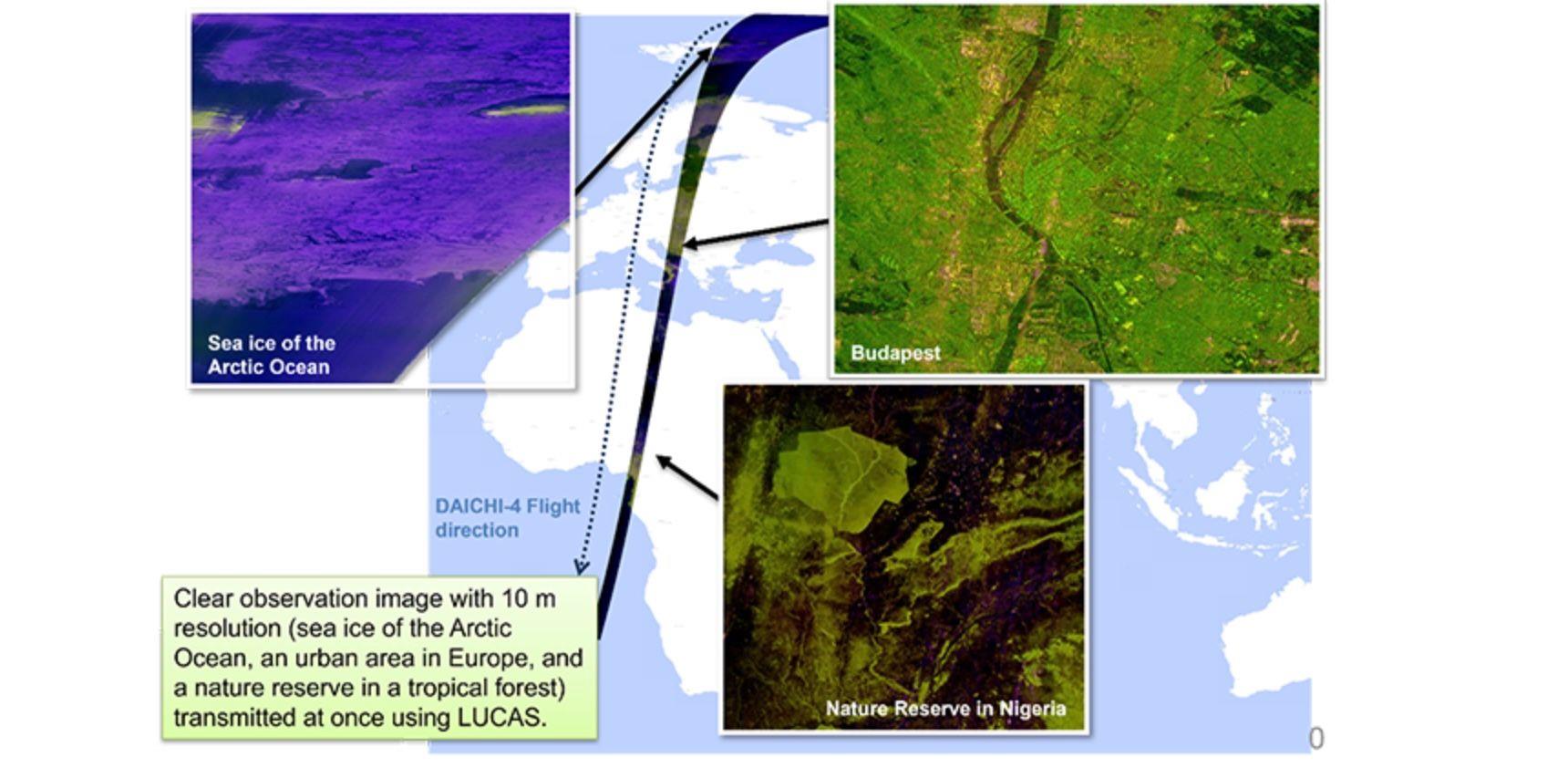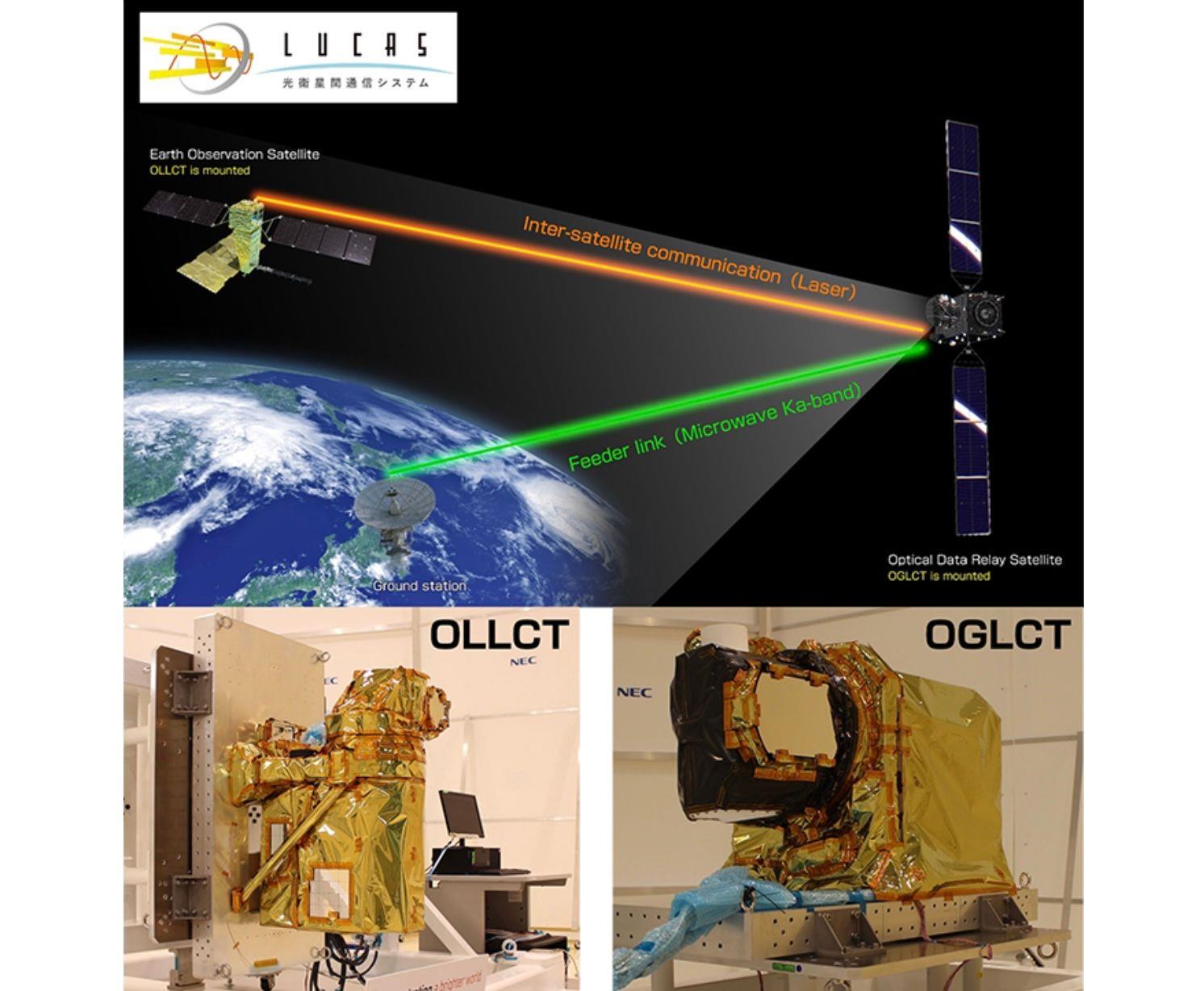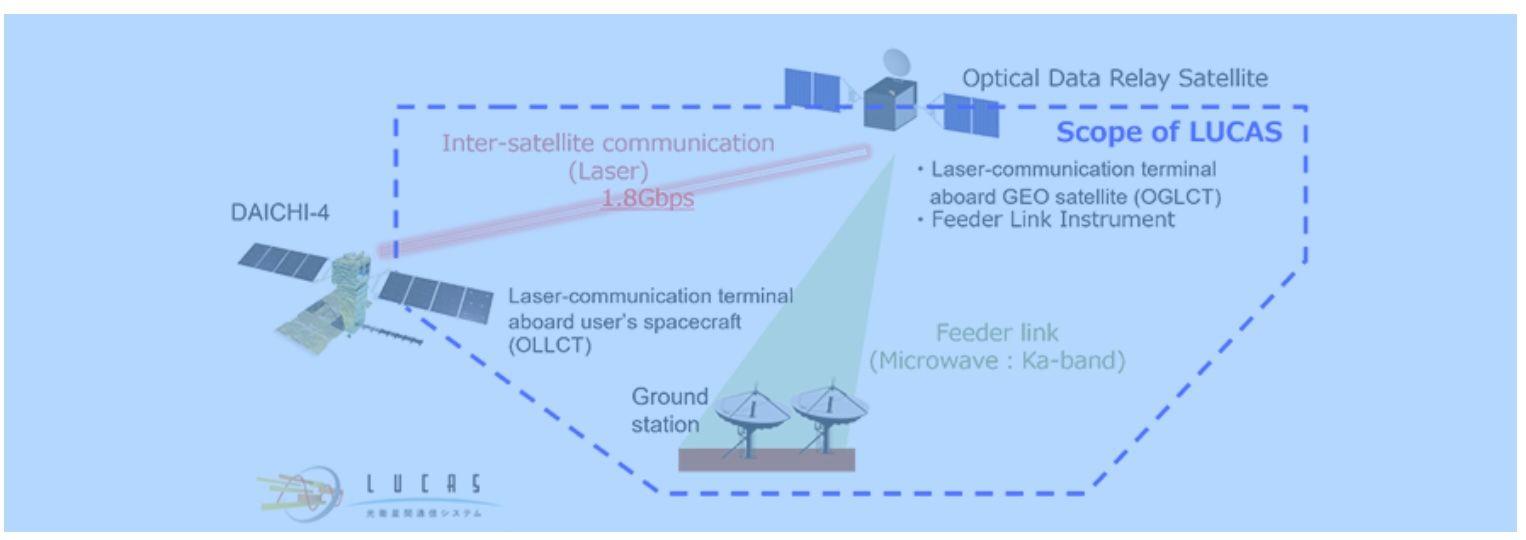(MENAFN- JCN NewsWire) World's First Successful Transmission of Huge Volume Mission Data Using 1.5 micron Optical Inter-Satellite Communication
- JAXA and NEC's Initiatives in Optical Communication in Space -
TOKYO, Jan 24, 2025 - (JCN Newswire) - Japan Aerospace Exploration Agency, and NEC Corporation , the prime contractor of the laser-communication terminals for the Laser Utilizing Communication System (LUCAS)(1), performed the world's fastest optical communication (wavelength band: 1.5 μm, communication speed: 1.8 Gbps) using LUCAS between the Advanced Land Observing Satellite-4 "DAICHI-4" (ALOS-4)(2) and the Optical Data Relay Satellite in geostationary orbit at a distance of about 40,000 km, and successfully completed the first transmission of observation data to a ground station through the geostationary satellite.

Figure 1: Observation image of "DAICHI-4" transmitted by LUCAS. Observed in the initial calibration and validation phase. Downlinked a zonal range of observation data at once, successfully acquired a large amount of data immediately, which would typically require division into multiple paths for direct transmission to a ground station. (Above images, processed with pseudo-color, such as the sea ice of the Arctic Ocean are enlarged to highlight a specific portion of observation area). ©JAXA
In October 2024, JAXA and NEC successfully achieved the optical inter-satellite communication(3) between "DAICHI-4" equipped with the Optical Leo Laser Communication Terminal (OLLCT) dedicated to an Earth observation satellite and the Optical Data Relay Satellite equipped with the Optical Geo Laser Communication Terminal (OGLCT) dedicated to a geostationary satellite, and we have continued technical demonstrations. As a result, we successfully transmitted "DAICHI-4" observation data using optical communication. The success of this data transmission utilizing LUCAS enables immediate downlinking of a large amount of observation data which is difficult to achieve through direct communication to ground stations in areas lacking accessible ground stations. Figure 1 shows the first image downlinked through LUCAS, generated from a large amount of mission data observed by "DAICHI-4" over approximately 30 minutes, traversing the Arctic, Europe, and the African continent. While direct transmission to ground stations requires multiple transmissions, the use of LUCAS narrowed the acquisition of observation data of vast areas to a single transmission.

OGLCT: Laser-communication terminal aboard the GEO (Geostationary) satellite(Optical inter-satellite communication instrument for GEO satellite)
Above photographs show only the optical components of the laser communication terminals mounted on the exterior of the satellites.
The optical component of OLLCT is smaller than that of OGLCT, resulting in improved mountability due to its reduced size.
Fig. 2: Overview of LUCAS ©JAXA/NEC
Laser light has a bandwidth that is orders of magnitude wider than that of radio waves (5 THz in the 1.5 μm wavelength band), allowing it to transmit more information than radio waves. In addition, by using highly focused beams, there is little risk of interference or eavesdropping. The use of laser light is essential for achieving high-speed, high-capacity communications in space in the future. In LUCAS, optical communication has been adopted in the data relay system onboard the geostationary satellite. By using optical communication between the Earth observation satellite and the geostationary satellite, LUCAS enables data transmission from the Earth observation satellite at "1.8 Gbps", that is a speed 7.5 times faster than the "240 Mbps" transmission rate of the Data Relay Test Satellite "KODAMA" (DRTS)(4) using previous generation radio waves. (Figure 3)

Figure 3: LUCAS enables high-speed/large-capacity data transmission at a speed of 1.8 Gbps via optical communication © JAXA/NEC
There is a distance of about 40,000 km between "DAICHI-4" in low orbit and the Optical Data Relay Satellite in geostationary orbit. The acquisition and communication of the counterpart satellite, which is moving at high speeds, requires precise optical systems and their control technology. Specifically, while the Optical Data Relay Satellite in geostationary orbit at an altitude of about 36,000 km moves at about 3.1 km/second and the Earth observation satellite in low orbit circles at about 7.6 km/second, it is essential to continuously direct the laser beam, which expands only about 500 m, accurately to the counterpart satellite even at a distance of 40,000 km. To achieve this, high-output optical amplification technology for the laser light and acquisition and tracking technology to direct the laser light towards the counterpart satellite are required.
In this project, NEC developed the overall system design of LUCAS and both the laser communication terminals for the Optical Data Relay Satellite and the Earth observation satellite, the key components of LUCAS(5). The use of the 1.5 μm band, which is the hallmark of LUCAS, was based on NEC's development achievements in terrestrial and underwater optical fiber communication systems and was also developed in anticipation of integration with this system in the future. Although the 1.5 μm band is relatively deficient in power efficiency, the recent success in long-distance high-speed transmission between the geostationary satellite and the low earth orbit satellite is expected to accelerate its utilization in space-based optical communication.
"DAICHI-4" also carries SPAISE3 (Space-based Automatic Identification System Experiment3)(6) developed by JAXA and NEC, which particularly observes vessels in crowded maritime areas. Also for the observation data of SPAISE3, the optical communication makes it possible to transmit a large amount of data in real time. Like this, high-speed data communication using LUCAS contributes to the utilization and promotion(7) of not only SAR data but also various data of other satellites, thereby playing a role as a social infrastructure that protects people's lives and safety.
JAXA and NEC have been engaging in optical communication in space since the 1990s. Optical communication in space is also identified as a technology of strategic importance in the Space Technology Strategy formulated by the Japanese government for fiscal year 2023. JAXA has advanced research and development in optical communication as a solution to the increasing capacity and immediacy requirements of data transmission for future Earth observation satellites. NEC has been responsible for designing the LUCAS system, manufacturing laser communication terminals, supporting satellite system tests, and managing the initial functional verification operations of satellite systems. Building on this success, we will continue to contribute to the advancement of Japan's space development by accelerating the technological development of the optical inter-satellite communication in collaboration with related organizations and partners.
(1) LUCAS: Laser Utilizing Communication System, developed and being operated by JAXA, is a system that enables data relay between an Earth observation satellite (low orbit satellite) and an optical data relay satellite (geostationary satellite) through optical communication in space using invisible laser light with a wavelength of 1.5 μm. (Japanese Only)
(2) Earth observation satellite developed and being operated by JAXA. This radar satellite expands the observation range up to four times while maintaining the high spatial resolution of its predecessor "DAICHI-2". (Japanese Only)
(3) JAXA Press Release on October 8th
(4) "KODAMA": Launched by the third H-IIA Launch Vehicle on September 10, 2002, and completed its operations on August 5, 2017. (Japanese Only)
(5) NEC develops laser communications terminals for JAXA's Laser Utilizing Communication System, "LUCAS"
(6) SPAISE3: SPace-based AIS Experiment 3. SPAISE is an abbreviation for the experiment (SPace-based AIS Experiment) where the Automatic Identification System (AIS) is mounted on a satellite. AIS is a mandatory for all passenger ships, as well as international voyage ships of 300 tons or more, and all vessels of 500 tons or more, in order to ensure navigational safety. (Japanese Only)
(7) JAXA Space Technology Directorate I Satellite Navigator "Satellite Applications" Share
About NEC Corporation
NEC Corporation has established itself as a leader in the integration of IT and network technologies while promoting the brand statement of“Orchestrating a brighter world.” NEC enables businesses and communities to adapt to rapid changes taking place in both society and the market as it provides for the social values of safety, security, fairness and efficiency to promote a more sustainable world where everyone has the chance to reach their full potential. For more information, visit NEC at .
Source: NEC Corporation
Sectors: Telecoms, 5G, Wireless, Apps
MENAFN23012025003415003250ID1109124485
Legal Disclaimer:
MENAFN provides the information “as is” without warranty of any kind. We do not accept any responsibility or liability for the accuracy, content, images, videos, licenses, completeness, legality, or reliability of the information contained in this article. If you have any complaints or copyright issues related to this article, kindly contact the provider above.